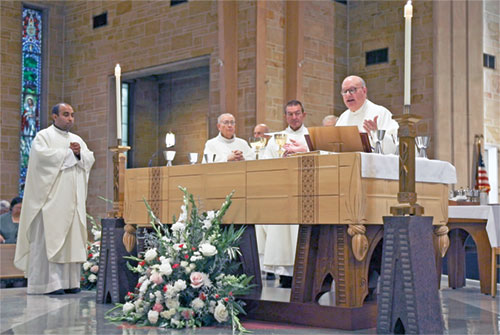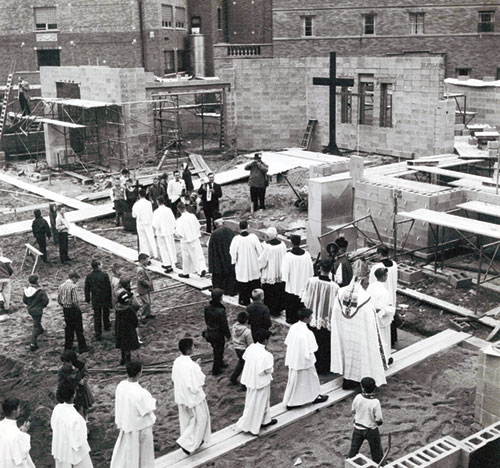Little Flower Parish celebrates 100 years as a neighborhood faith community

Msgr. William F. Stumpf, archdiocesan vicar general, right, prays the eucharistic prayer during a Sept. 13 Mass at St. Théresè of the Infant Jesus (Little Flower) Church in Indianapolis to celebrate the 100th anniversary of the Indianapolis East Deanery faith community’s founding. Concelebrating the Mass are, from left, Father Jude Meril Sahayam, Little Flower’s administrator, and retired Father Robert Gilday. Deacon Gary Blackwell, second from right, assists at the Mass. (Submitted photo by Caleb Baue)
By Sean Gallagher
During much of the archdiocese’s history, most of its parishes were started in places where Catholics were already living.
St. Théresè of the Infant Jesus (Little Flower) Parish on Indianapolis’ east side is an exception to that general rule.
In 1925, Indiana and the rest of America were in the midst of what became known as the “roaring ’20s” with a high-powered economy ruling the day.
Real estate developers approached Indianapolis Bishop Joseph Chartrand and offered him land east of Sherman Drive on the city’s east side for $1—on the condition that he would establish a parish with a school on the tract.
But the offer came with a risk. Bishop Chartrand was being asked to start a faith community on speculation. In 1925, no neighborhood existed there to populate such a parish and school. But the hope was that people who lived close to downtown Indianapolis in the heady economy of the time would want to move further east into the new neighborhood that the developers wanted to create.
Bishop Chartrand weighed the risk and accepted the developers’ offer. In March 1925, he announced the organization of Little Flower Parish, which would be located at the intersection of 13th Street and Bosart Avenue. The first Mass was celebrated in a nearby building in early July.
As St. Théresè of the Infant Jesus was declared a saint on May 17, 1925, Little Flower Parish claims that it is the first parish in the world named after the popular saint.
St. Théresè had died only 28 years earlier. But her spiritual autobiography The Story of a Soul, published the year after her death, had become a worldwide sensation. In that book, St. Théresè, a French Carmelite nun who was only 24 when she died in 1897, humbly referred to herself as simply a “little flower” in the garden of the Lord.
That quickly became her nickname, and so it also served as the common name for the new parish and the name of the neighborhood that grew up around it.
Within three decades after Bishop Chartrand took the risk to found Little Flower Parish, it had become the largest faith community in the archdiocese in terms of the number of its households. Its school in the mid-1950s had more than 900 students.
That was the Little Flower Parish in which Father Robert Gilday grew up.
“It was a destination parish,” said Father Gilday, 75, who retired from active ministry in July after serving as Little Flower’s pastor since 2003. “People would come and say that they wanted to move into Little Flower.
“Back in the day, this parish was a perfect bell curve. You had people who were poor. You also had people who were actually quite wealthy. Most were somewhere in the middle. It had a draw to all kinds of people.”
Little Flower continues to have a strong community of parishioners, even if it is no longer the largest parish in the archdiocese. A large portion of its members now live far beyond the confines of the neighborhood that grew up around it.
Many of them gathered on Sept. 13 to celebrate the centennial of the parish’s founding with a Mass celebrated by archdiocesan vicar general Msgr. William F. Stumpf and to share a gala dinner together.
‘It feels like home, like family’

Archbishop Paul C. Schulte, priests and altar servers take part in a 1961 procession on the building site of St. Théresè of the Infant Jesus (Little Flower) Church in Indianapolis to bless the cornerstone of the east side faith community’s church. (Submitted photo)
Little Flower’s new administrator Father Jude Meril Sahayam spoke with The Criterion about how humbling it is for him to begin his ministry there at the time of its centennial.
“I feel really small being a part of this great tradition and culture that they have in this parish, celebrating the 100th year,” said Father Sahayam, who also ministers as administrator of Our Lady of Lourdes Parish in Indianapolis.
Although humbled to be asked to lead Little Flower, the priest from the Diocese of Palayamkottai in southern India has an appreciation from his native culture for the parish that is located not on a main thoroughfare but is in the middle of a neighborhood.
“There’s a saying in Tamil, my native language, that if there is no worship place in your neighborhood or village, don’t live there,” Father Sahayam said. “That’s what this reminds me of, being part of a neighborhood. Christ is always a part of this neighborhood.”
The ties of Catholic families who lived in the Little Flower neighborhood to the parish has been strong enough that many people who grew up in the neighborhood continue to be members of the parish after moving farther away.
Kurt Schnell grew up in Little Flower neighborhood in the 1970s and 1980s.
“Growing up, when I was a kid, I thought it was such a neat thing to have the parish so close,” he said. “You could see the church. The parking lot was our playground. It was a gathering place.”
Schnell now lives in Beech Grove, several miles south of his old neighborhood. But Little Flower is still his spiritual home. He helps lead Bible study groups there with parishioners who hail from as far away as the north side of Indianapolis to New Palestine and Shelbyville.
“It’s amazing how people will drive that far and pass two or three other parishes to get to Little Flower,” he said. “I don’t have any intention of ever leaving Little Flower. It’s my home.”
It’s also home for Jessica Freudenstein, who helps lead special education efforts in Little Flower School. She grew up blocks away from the parish, graduating from the eighth grade of its school in 2001, but now lives with her family in Wanamaker in southeastern Marion County.
“You lived close with people in the parish,” Freudenstein said of her time growing up near Little Flower. “You went to school with them. Your activities and sporting events were all around each other. We formed bonds, friendships and traditions.”
Her two daughters Mya and Macy, current Little Flower students, are the fifth generation of her family to be members of the parish.
Father Gilday was an altar server at her grandparents’ wedding Mass. He celebrated the wedding Mass for Jessica and her husband Corey.
“It feels like home, like family,” said Freudenstein. “Getting to share that with my children is just a blessing.”
Influential pastors
Father Gilday has been tied to Little Flower Parish for nearly three quarters of its history. His family moved into the neighborhood in 1952 when he was 3.
He knows well how different pastors of Little Flower contributed to making it a strong community through its 100 years.
In an interview with The Criterion, he named three pastors who helped shape Little Flower: Father Charles Duffy, Father John Riedinger and Msgr. Raymond Bosler.
Father Duffy was the founding pastor of Little Flower, leading it until his death in 1939. “The founding pastor always sets the tone and personality of a parish,” Father Gilday said.
Father Riedinger was Little Flower’s pastor from
1942-66 and oversaw the building of its church, which was completed in 1962. Previously, the parish had worshipped in its school gym.
Building a church “was Father John’s dream,” recalled Father Gilday of the pastor of his childhood and teenage years.
“He was the builder,” Father Gilday said. “He built most of the buildings here, plus the church. He had a vision.”
Msgr. Bosler, who had attended the Second Vatican Council as a “peritus” (a theological expert) under Archbishop Paul C. Schulte, served as Little Flower’s pastor from 1966-77.
“He came and all of a sudden, Little Flower was thrust into the world of Vatican II,” Father Gilday said. “People were hearing about it in ways that they hadn’t heard before.”
Although he led his home parish for nearly a quarter of its history, Father Gilday didn’t include himself in the list of its most influential pastors.
“We improved some things,” he said. “But I didn’t build anything. I really kind of carried on what was going on.”
Multicultural and multigenerational
During the 22 years that Father Gilday led Little Flower, he saw changes happening in the parish.
“Over the years, so many of the longtime parishioners have died and some new people have moved in,” he said.
Father Gilday also observed that there has been a growth in the racial and ethnic diversity of the school’s students, something that Father Sahayam noticed, too, in an early visit to the school.
“I visited one of the classrooms, and one of the girls said, ‘You look like me,’ ” said Father Sahayam with a laugh. “Even the children are aware that they’re in a multicultural situation.”
As the parish changes, members like Freudenstein with deep roots in the faith community are dedicated to contributing to its future.
“I think we’re still known as a parish and school that [are] close knit and want to have all those connections and activities that involve our community,” she said. “We’re still known as that, even though it’s not quite like it used to be. It’s still important to us.”
And as seen in parishioners like Freudenstein, Little Flower also continues to be a multigenerational faith community as its multicultural aspects grow.
“Those two things will make the parish rich,” said Father Sahayam. “It will move us forward into a great future.”
(To learn more about St. Théresè of the Infant Jesus [Little Flower] Parish in Indianapolis, visit littleflowerparish.org.) †

